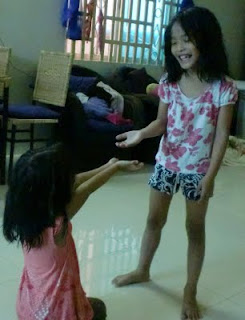I have several strategies for working on Khmer. One is formal lessons. Every weekday morning, I go downtown to a language school for one-on-one tutoring. I love this school because they’re great at making me practice what I’ve learned. My tutor brings in baskets of plastic fruit for me to describe, makes me pretend to be buying or selling clothing, and asks me to tell stories about someone brushing their teeth or rowing a boat. It’s all in Khmer, except an occasional English definition. Even when I leave the tutoring session, the cleaners and receptionists seem genuinely interested in chatting. They ask why I brought my backpack today, what I miss about America, how I scraped my knees. It’s a very warm environment, and they’ve helped me so much. If only I could continue there once school starts!
After that, I often practice with Khmer speakers at Logos school or with people in my neighborhood. Since I’m new to this neighborhood, it still takes a lot of energy and courage for me to start a conversation. But if I’m buying vegetables or a phone card, they usually ask me how long I’ve been in Cambodia, and I ask them about their family or which province they’re from. It’s exciting when I can turn it into a longer conversation, even if that’s not always the case.
I love the elementary teaching assistants (TAs) at my school, but I never see them during school because they have a different schedule. During summer school, though, the kids leave by lunchtime and I can sit and eat with the TAs as long as we want. They love teasing me in Khmer, and I can get bits and pieces of their conversations with one another. The office staff has also been super-helpful in practicing with me...they’re all so sweet.
When I get home, sometimes I sit in on Chrismoon and Elizabeth’s writing lesson. They’re ahead of me, but not by too much, since they’re only 7 and 8 and attending school mostly in English. Lessons involve Sovannary chanting the equivalent of “C-A-T spells cat!” and us repeating it. Later, to review, they have to read it on their own or spell words she dictates, but I can’t quite keep up with that part yet since I don’t know the whole alphabet. My lessons with her this spring focused mainly on the alphabet, but this summer I’ve abandoned that to focus on speaking and listening. I figure the more vocab I know, the more I’ll be able to understand what I’m reading. Writing helps with pronunciation, but beyond that, it’s not terribly useful here – only for some store signs, newspapers, karaoke lyrics, and hymnals. There are few books printed in Khmer, and even most food labels are printed in other languages.
Dinner is the main time Sovannary’s family is together and speaking Khmer, though there are snatches of conversation at other times. Traditionally, Cambodians don’t talk while eating. (This is true of Koreans and probably other Asian cultures too.) However, Sovannary’s family is pretty lax about this, and with 2 little girls, there’s lots of, “Hurry up and eat your rice!” or negotiating about the quantity of vegetables to be eaten and whether they can add extra fish/hot dog to make it taste better. (Elizabeth is obsessed with hot dogs! She put on a 10-minute puppet show that was essentially an ode to hot dogs, although Cambodian hot dogs are far sketchier than their US counterparts.)
After dinner, Sovannary often takes time to help me practice speaking, or we just have conversations in English. She’s a deep thinker: her questions for me include, “How does the US deal with population control?” and “Which country do you think has the worst pollution worldwide?” That makes her an anomaly in Cambodia. Though our conversations aren’t always in Khmer, I’ve still learned a lot about Khmer culture from them, and I really appreciate our chats.




